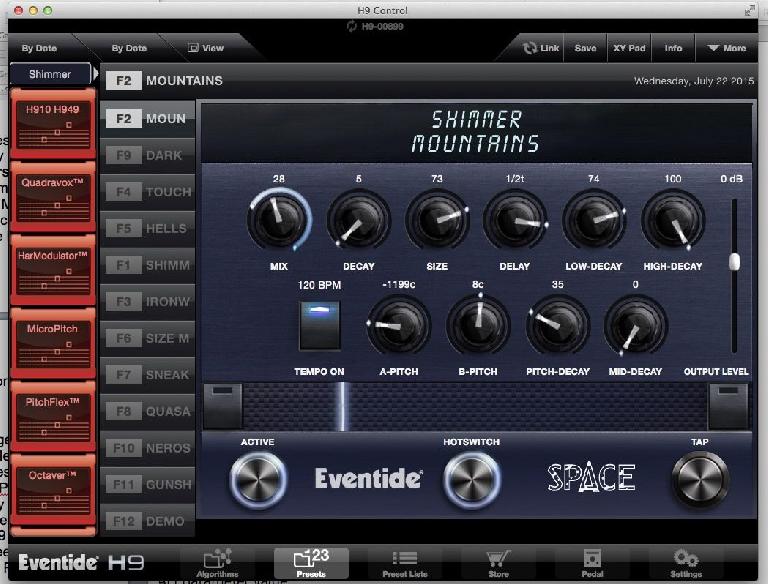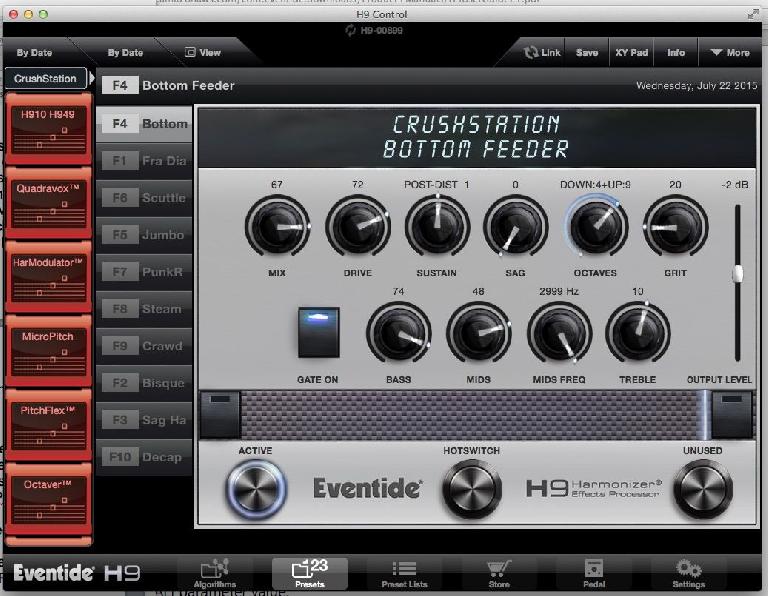Occasionally, a product comes along that can be referred to as ‘game changer’. Without hesitation, I feel that Eventides H9 Harmonizer Effects Processor pedal belongs in that category.
The Basics
The H9 is a multi effects guitar pedal that can ‘run’ the algorithms and presets from Eventides stompboxes; TimeFactor, PitchFactor, ModFactor, and Space. It also includes additional sounds and their newest Crushstation distortion algorithms.
It has a one-knob user interface with only an LED display, a few pushbuttons (Hot Knob, X, Y, Z and Presets), two momentary action footswitches for tapping tempos, changing presets and bypassing (true analog bypass), and tuning with the built-in tuner. It's got ¼” stereo Inputs and Outputs, an Expression pedal jack, MIDI I/O and mini-USB connectivity.
Currently, the H9 comes in three packages. The H9 Core is preloaded with pitch and delay effects from Eventide's original studio harmonizers. The H9 Greatest Hits is preloaded with 9 algorithms and 99 presets from their stompbox line. The H9 Max features all the algorithms and presets, including all future algorithms. Of course the hardware box itself remains the same no matter which ‘version’ you choose.
Game Changer
To me, what makes the H9 a game changer is the fact that it can be endlessly updated. While it is controllable from the front panel, it features the ability to connect via Bluetooth to iPods, iPhone or iPads (running iOS 5 or above) for virtually unlimited tweaking, preset management, editing and creativity. You can also connect to H9 Control (via mini USB or Bluetooth), which is a free editor/librarian that runs on both Mac and PC platforms.
It features the ability to connect via Bluetooth to iPods, iPhone or iPads for virtually unlimited tweaking, preset management, editing and creativity.
For the algorithms that you do not have initially, they can be purchased easily from the iTunes store for about $20 each—so loading the H9 on your own is quick and easy. You can also try out any of the algorithms before you buy them, albeit temporarily. That gives you enough time to know whether or not you want to purchase them.
The Sounds
The sounds, and the editing of them, are also another factor that make this pedal a game changer. These are high level, pro quality studio sounds in a modern stompbox. The reverbs are deep, the choruses and flanges are lush and the delays and echoes are spot on. Throw in some useful rotary effects, a palette of distortions and classic Eventide pitch effects, and this little box becomes a monster.
In Use
While you can plug this directly into your amp in mono, I’m a huge fan of using the H9 in full stereo—especially since I use it mostly in the studio. In that case, I use the Left and Right outputs and run them into a pair of recording channels, which then feed my DAW (In my case, Pro Tools HDX at home and Pro Tools/Universal Audio Apollo’s for mobile).
In my home studio I use a pair of Millenia HV-37’s or Focusrite ISA 428s. Up at Clubhouse Studios in Rhinebeck, NY, where I record quite a bit using the live room and Neve, I run it through a Grace m906.
My point being, good clean, uncolored preamp channels deliver the best results on a box of this quality. However, that’s not to say plugging it right into your Universal Audio Apollo or Avid MBox won't sound great, it will! I’ve used both of those with the H9 and it still holds up—which is a testament to the quality of the manufacturing, the A/D and D/A converters and care that went into this.
I love to plug bass into this and record full-blown stereo bass with effects.
I’ve used it already on a ton of TV cues, using a variety of guitars—Teles, Les Pauls, cigar boxes, baritones and even DI’ed 12 strings and analog synths. I love to plug bass into this and record full-blown stereo bass with effects and all—especially for larger ambient pieces.
When at home, I tend to use the H9 Control, which I run on my Mac Pro. When I’m doing a remote session, which I do quite a bit of, I turn to my iPhone or iPad. All I need to do is go into my Bluetooth settings, and under MY DEVICES enable the H9. It will then connect the phone or iPad to the pedal (registered in my name) and away I go. Just today for example, I did a session in a co-composers studio where I plugged the H9 into his Apollo, and called up a number of sounds on my iPhone, tweaking the parameters on the spot as needed for each track we laid down. It’s truly an amazing way to work.
Stereo Amps
It also sounds really cool when plugged into two amps in the studio, and miked accordingly. This is a case where you would let the amp do the work of pushing the sound out into the room, and the H9 handles your creative sound designing. Since you can independently tweak stereo delay times for example, choruses and flanges become epic when recorded using a pair of amps. Of course the same applies for rotary effects and delays, it just takes on a life of its own.
You could also run the H9 in and out of your console and/or DAW and use it as an external effect box.
Note that you could also run the H9 in and out of your console and/or DAW and use it as an external effect box. In the latest software update (V5.2), there are additional Pre/Post and Wet/Dry routing options allowing you to change where the H9 sits in the signal chain, etc.
Expression Pedal
Plugging in an expression pedal lets you control any combination of parameters, and it is identical to the HOTKNOB. The H9 will auto-calibrate your pedal just by plugging it in and rocking it fully (heel to toe). When pressed all the way down, the LED will read 100. When fully up, it will read 0. I tend to set the Expression pedal the Mix and/or Size parameters, so in real-time I can control the amount of H9 effect, and the Size of the reverb (at least that’s what I tend to use most). The expression pedal lets me control this hands-free, but of course, I could use the HOTKNOB if I wasn’t playing.
It's a Wrap
Another thing that puts the H9 into my game changer category is that you’re inspired to create from the moment you hit your first notes. A standard guitar chord takes on a life of its own when run through the Space Shimmer preset for example, and the ear candy makes you play differently because it just sounds so damn good. That’s just one of the large number of presets that let you get creative with the H9. Every time I plug into it, something new and interesting comes out, and that’s a game changer.
Price: H9 Core - $399 / H9 Harmonizer - $499 / H9 Max - $699
Pros: Bluetooth and Desktop control of parameters, Studio quality sounds in a stomp box, Expandable, Excellent variety of sounds
Cons: Without the app or Control, you have to understand how the pedal operates, so watch the videos, LED screen could reveal more info overall
Web: https://www.eventideaudio.com/products/stompboxes/multi-effect-processor/h9







 © 2024 Ask.Audio
A NonLinear Educating Company
© 2024 Ask.Audio
A NonLinear Educating Company
Discussion
Want to join the discussion?
Create an account or login to get started!